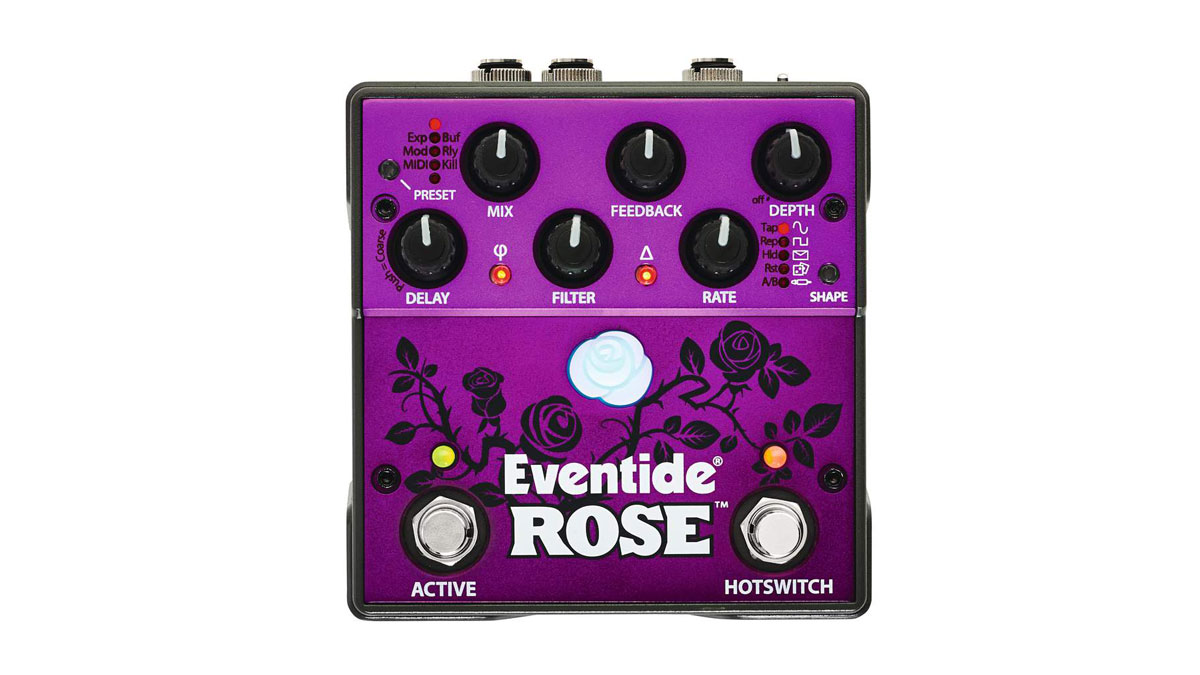MusicRadar Verdict
Creative delay versatility in a box, Eventide’s Rose is a smart addition to any ’board.
Pros
- +
Hugely versatile in its range of sounds.
- +
Nice morphing between sounds.
- +
Varied modulation types.
- +
Reverse switch.
Cons
- -
Only one external input - we’d liked to have seen expression pedal and extra footswitching together.
MusicRadar's got your back
Eventide, a long-established brand in rack-mounted studio processors, was one of the first to bring out large high-grade effects pedals with multiple programs.
The TimeFactor (delay), ModFactor (modulation), PitchFactor (pitch) and Space (reverb) were quite thematic in that they offered variations on a specific effects type, but its most recent - and smaller - H9 pedal was more like ‘Eventide’s greatest hits’, covering everything.
For the Rose, then, the company has kept a smaller form factor but has gone back to a more specific theme, describing the pedal as a modulated delay. With a hybrid mix of analogue and digital components, the pedal pairs an analogue signal path with a digital delay line that has five modulation sources.
The Rose has a very broad standard delay range that apparently runs from 10 microseconds right up to 10 seconds, which gives it real flexibility in the sounds it can produce. Besides the massive range of timings available for standard delays with audible repeats, the very short delay times are used for time-based effects such as comb filtering, chorus and flanging. The delay time is set by the Delay knob, which, pushed then turned, progressively selects 10 delay ranges (the selection is indicated by the combination of lit LEDs on the Preset LED ladder). Once a range is set, the normal action of the knob fine-tunes the delay time within that range and will give you up to 10 seconds in the highest range. If you want more than that, there’s a Delay Multiplier button that can offer two, three, four and five times the range, to a maximum of 50 seconds.

A Mix knob goes up to 100 per cent wet, while Feedback can be turned up for a very smooth transition into self- oscillation. Next, the Filter knob is a classic analogue low-pass filter that smoothly winds off the top-end, giving the repeats a tonal character more associated with an analogue BBD or tape device, and toning down the stridency of any chorus, for example, to sit it in context. Modulation is added with Rate and Depth knobs, with a choice of five modulation sources: sine wave, square wave, random, envelope and external. Then the Phi switch gives you reverse delay, except for the shortest delay times (below 20 milliseconds) where its function is to flip the phase.
Five onboard presets store your settings, but in effect you’re getting five banks of two presets, because each has an A/B pair of settings. Instantly switching from A to B can be assigned to the Hotswitch footswitch, or you can use an expression pedal to morph between A and B. The Hotswitch can alternatively be used for tap tempo, engaging infinite repeats, or holding/resetting the modulation, and there’s the possibility of plugging a triple footswitch into the expression pedal input for these functions and more, including changing presets.
Sounds
There’s loads of sonic territory to explore in this excellent-sounding pedal. From the shortest delay times, you can dial in some altered metallic tonality and create a huge variety of chorus, flanging and rotary speaker-like sounds. Beyond that, there’s a full range of tonally varied delays, with or without modulation, and special mention must go to the backwards function: it’s one of the best we’ve heard - smooth and natural and encouraging play.
Want all the hottest music and gear news, reviews, deals, features and more, direct to your inbox? Sign up here.
There’s a huge variety of conventional delay effects on tap, but the other side of the coin is that this thing can also get quite bonkers, especially if you hook up an expression pedal or aren’t averse to real-time knob twiddling. The fact that it’s being used by Adrian Belew and Vernon Reid - players unafraid to get ‘out there’ - amply demonstrates that. While you can set up some extreme modulation-like repeats that descend in pitch dependent on your dynamics, there’s loads of mileage in playing along with yourself, creating loops and using the Multiplier button to change pitch and time. The Rose is the sort of pedal you can get lost in for hours.
Trevor Curwen has played guitar for several decades – he's also mimed it on the UK's Top of the Pops. Much of his working life, though, has been spent behind the mixing desk, during which time he has built up a solid collection of the guitars, amps and pedals needed to cover just about any studio session. He writes pedal reviews for Guitarist and has contributed to Total Guitar, MusicRadar and Future Music among others.

